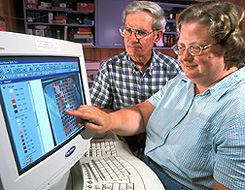| 
Technician Ray Adams and plant physiologist
Gretchen Sassenrath examine a map of fiber quality data created with a
geographic information system. Click the image for more information about
it.
Read the
magazine
story to find out more.
|
New Sampling
System Helps Growers Learn About Their Fields
By Jim Core
October 6, 2004 A new cotton sampling system
developed by Agricultural Research
Service scientists helps growers determine the different fiber qualities
produced by their cotton plants throughout a harvested field.
ARS plant physiologist Gretchen Sassenrath worked with technician Ray Adams
in the ARS Application and
Production Technology Research Unit at Stoneville, Miss., to design a
method of spatially sampling cotton during harvesting operations. The system
helps determine what underlying factors, such as soil moisture, may be
affecting the fiber properties.
Soil properties will alter the moisture and temperature in a small area of a
field, changing the individual microclimate for that area. For instance, if
areas of a field have changes in soil quality, varying temperatures or
different amounts of water collecting throughout it due to terrain features,
cotton fiber properties may vary.
Adams built a cotton sampler that attaches to the picker's chute. A lever
switches a paddle gate in the picker chute and, every 20 seconds, diverts some
of the harvested cotton into a sampler chute for collection and later analysis.
The cotton sample is harvested from a known area of the field. Fiber properties
are then incorporated with the position data and entered into the database for
spatial analysis.
The system works alongside the cotton yield monitor, a device that measures
the quantity of cotton at any given position in the field. The yield monitor is
equipped with a Global Positioning System receiver to compute position, speed
and time.
The data from the yield monitor and the fiber properties are then entered
into the geographic information system (GIS), a database that processes
geographically-based information. A GIS map shows growers which areas of their
fields need more attention and which areas are producing cotton bolls with the
best fiber properties. Once the cotton fiber properties have been determined,
the value of the cotton lint is calculated from the same tables that farmers
use when selling their cotton.
Read
more about this research in the October issue of Agricultural
Research magazine.
ARS is the U.S. Department of
Agriculture’s chief scientific research agency.
|